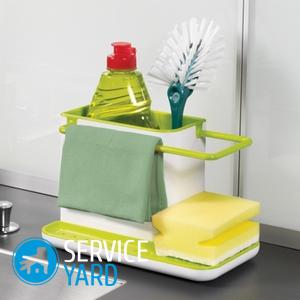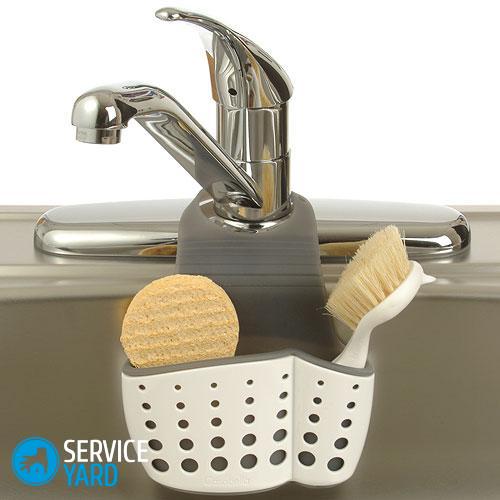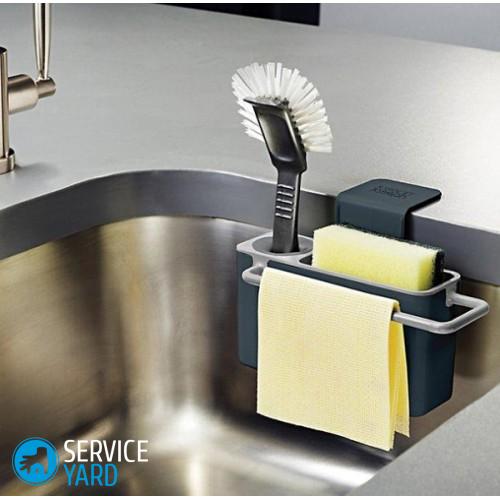Sponge for dishes

Do not wash the dishes after eating whether those people who prefer home-made food can afford a restaurant. Those who cook a family breakfast, lunch, dinner at home every day are simply obliged to do this not always pleasant job. And to speed it up and bring the dishes to perfect cleanliness and shine, a sponge for dishes is usually used. But you can get the expected effect only if you choose the right device and apply it to the appropriate type of dishes. In this article, we will consider what a sponge for washing can be, how to choose it, apply it and what else you need to know when using such home equipment.
to contents ↑How to choose a sponge
In order for the dish sponge to be really useful, convenient and significantly accelerate the process of washing dishes, you should pay attention to the following when buying:
- the material from which it is made;
- form;
- sizes.
to contents ↑Important! It will not be superfluous to clarify the manufacturer to be sure that no harmful substances were used in the production of such household products.
What do dishwashing sponges make?
The variety of dishwashing sponges is incredibly large today. Some are suitable for specific dishes, others are universal. To quickly understand all this wealth of offers of modern manufacturers, you need to know the following features of each material.
Foam rubber
Foam sponges are the most popular today because of their advantages and affordability.
Pros:
- This material is soft, moderately delicate, therefore it can be used to remove grease from absolutely any surface, even with a very specific Teflon non-stick coating.
- A foam sponge foams any detergent very well, saving it.
- Low price.
- Convenient packaging with a different number of sponges - you can choose the packaging, focusing on your volume of dirty dishes every day.
Minuses:
- The downside of such a device is its fragility.
- If you purchase a poor quality product, during wetting and drying, the foam will crumble right in your hands, leaving particles on the dishes. This will cause a certain inconvenience and additional water consumption for repeated washing of kitchen utensils.
Abrasive and foam rubber
Sponges with a double surface type with the appearance on the market of household products immediately began to be in greater demand than conventional foam products. There are several reasons for this.
Benefits:
- The price has remained affordable - the increase in cost compared to single-sided foam products is insignificant even for those who seek to save on everything.
- Universality of application. Such a washing sponge is suitable for removing grease and light impurities from any, even delicate materials of kitchen utensils, and for thoroughly washing the burnout. If necessary, with such a sponge you can clean the tiles on the walls, stove, bathtub, sink - everything that will be convenient to wash it.
- Good foaming of concentrated detergents.
- Possibility of acquiring both 1 piece and packaging of several multi-colored sponges.
Disadvantages:
- It is important to purchase products from a reliable manufacturer. Otherwise, either the foam will crumble, or the abrasive surface will not be rigid enough.
Metal
Mistresses have been using metal “hedgehogs” for decades.The basis of such a device, as a rule, is a thin wire twisted into a not very dense ball.
Benefits:
- Cheap price.
- Such a sponge for dishes is great for removing even the oldest dirt and a thick layer of soot.
- Long service life, if the basis is high-quality and durable wire.
Disadvantages:
- Not suitable for cleaning delicate surfaces - enamel, plastic, non-stick coatings.
- With a thick layer of soot and soot, during operation, the fat mixed in the cleaning agent may clog between the wire threads. The washing sponge becomes sticky and very unpleasant to use.
- It is undesirable to use for regular washing of kitchen utensils every day, since such a sponge will not absorb and will not remove liquid fat, and the remaining food will be clogged between the wires.
Cellulose
Cellulose washing sponges are also present in the species line of various manufacturers of household chemicals and improvised tools. And they are recommended to give preference to employees of the centers of analysis and certification of various goods.
Pros:
- Ecological purity of raw materials in the basis.
- Hypoallergenicity.
- Antibacterial properties.
Disadvantages:
- Not always a reasonable price.
- Such a sponge is suitable for washing not only dishes, but also any plumbing, especially one where a high level of hygienic cleanliness is required - a bathtub, a sink.
Plastic
Modern production is not complete without plastic, including sponges for dishes are also made from it. What features are typical for these products.
Pros:
- Long period of use.
- An opportunity to clear even difficult pollution - plastic products differ in a certain degree of rigidity.
- Delicate cleaning of dishes from any material.
- Acceptable price.
Minuses:
- The synthetic composition, therefore, you must be confident in the manufacturer so as not to harm yourself and your loved ones.
- The risk of allergies.
- Regular daily use is undesirable.
Microfibre
A sponge for dishes made of this material is very interesting from all sides.
Pros:
- The use of detergent is not required - the sponge for washing itself perfectly cleans even a large amount of fat.
- Hypoallergenic and environmentally friendly composition.
- Suitable for regular daily use.
- Gently cleans surfaces of any materials.
Minuses:
- High price compared to any other species.
- It is quite difficult to remove a thick layer of soot with such a sponge.
to contents ↑Important! As a rule, in the arsenal of every housewife there should be more than one type of sponge for dishes. It is advisable if different devices are present in one or another quantity, with which you can quickly and easily clean different surfaces, containers.
How to choose a sponge in size and shape?
Size and shape are also important on the quality of dishwashing. Therefore, these parameters you simply must pay a certain proportion of your attention. In doing so, consider the following recommendations:
- Small sponges - well suited for washing glasses, cups, glasses, but not very convenient for washing bulky plates, pans and pans. Are cheaper, but also wear out faster.
- Large format dishwashing sponge - more convenient for large kitchen utensils, lasts longer, but costs a little more.
- Rectangular sponges are a traditional version of a dishwashing fixture that does not cause any discomfort during use.
- Products with finger recesses - are considered an improved version with a higher level of ergonomics. According to manufacturers and some housewives - they fit better in the hand and are more convenient, since they do not slip out.
- Round and oval - very convenient for washing large bowls and pots.
- Sponges with plastic handles - convenient in terms of protecting the skin of the hands and manicure. It helps to clean not only ordinary plates and pans, but also containers with a narrow neck - bottles, vases, jugs.
to contents ↑Important! The color scheme is always at the personal discretion.The manufacturers of such inventory made sure that each housewife was able to choose a more interesting and enjoyable option. So, for example, a sponge for dishes can be in the same color scheme as kitchen towels, curtains or decor on the walls, facades of a furniture set.
Useful Tips:
- Innovative melamine sponges are an excellent solution for cleaning different surfaces of furniture, floors, and not only in the kitchen. But washing dishes with such devices is categorically not recommended due to the specific chemical composition of the products - melamine resin penetrates the structure of different materials. The only where the rare use of such a kitchen accessory is permissible is the outer walls of enameled pots, cauldrons.
- To ensure your safety, change your sponges at least once a week, especially if you have a large family and your usual lunch consists of several dishes. On such an inventory various harmful microorganisms accumulate, which every day becomes more and more in the thickness of the material of the sponge. The result of this phenomenon may be, at least - intestinal disorders.
- To save on buying a new washing sponge, you can disinfect an already used one - once a week. This can be done using vinegar, a microwave oven or a dishwasher. For processing, it is enough for 1 minute to place the sponge on the saucer in the microwave or load it into the dishwasher for the full duration of the dishwashing cycle. If you decide to disinfect with vinegar, place the sponge in it completely for 5 minutes, and then rinse thoroughly with running water.
Stock footage
Now you have complete information not only about the types, materials, forms, purpose of washing sponges, but also have some valuable tips on how to keep dishes clean and healthy. Use these recommendations all the time and let the perfect order always reign in your kitchen, for the maintenance of which you will spend negligible time.
- How to choose a vacuum cleaner taking into account the characteristics of the house and coatings?
- What to look for when choosing a water delivery
- How to quickly create comfort at home - tips for housewives
- How to choose the perfect TV - useful tips
- What to look for when choosing blinds
- What should be running shoes?
- What useful things can you buy in a hardware store
- Iphone 11 pro max review
- Than iPhone is better than Android smartphones





